 A Viking-era mixed hoard of coins and hack silver has been discovered on the Isle of Man. The group of 87 coins and 13 pieces of cut up silver arm-rings were discovered in April by retired police officer Kath Giles who has redefined beginner’s luck by finding four, count’em, four hoards since she began metal detecting three years ago. Only last December she discovered a magnificent assemblage of braided gold arm ring, cut silver armband and giant ball-type thistle brooch.
A Viking-era mixed hoard of coins and hack silver has been discovered on the Isle of Man. The group of 87 coins and 13 pieces of cut up silver arm-rings were discovered in April by retired police officer Kath Giles who has redefined beginner’s luck by finding four, count’em, four hoards since she began metal detecting three years ago. Only last December she discovered a magnificent assemblage of braided gold arm ring, cut silver armband and giant ball-type thistle brooch.
The coins were minted between around 990 and 1030 A.D. in England, Dublin, Germany and the Isle of Man. Most of them are silver pennies and bear the faces of King Cnut of England, Denmark and Norway, King Aethelred II of England and Holy Roman Emperor Otto I. The coins struck in Dublin and Man bear the image of King Sigtrygg Silkbeard, the Hiberno-Norse King of Dublin from the 990s until his abdication in 1036. The dates of the coins indicate the hoard was deposited around 1035 A.D., so right at the end of Silkbeard’s reign and in the waning decades of Viking Age hoard depositions on the Isle of Man.
 Located in the middle of the Irish Sea, the Isle of Man was at the intersected of active trade routes linking Ireland, England and northern Europe during the Viking Age. This is represented in the diversity of coinage found in hoards from this era, and in the prevalence of hack silver, old jewelry cut into pieces for use as currency based on the purity of the precious metal content.
Located in the middle of the Irish Sea, the Isle of Man was at the intersected of active trade routes linking Ireland, England and northern Europe during the Viking Age. This is represented in the diversity of coinage found in hoards from this era, and in the prevalence of hack silver, old jewelry cut into pieces for use as currency based on the purity of the precious metal content.
A comparable albeit far larger mixed hoard was discovered in Glenfaba in 2003. It dates to the same period, around 1020 A.D., and also contains a combination of Hiberno-Norse and Anglo-Saxon coins with a hefty proportion of hack silver.
[Numismatist Dr. Kristin] Bornholdt Collins said:
“The Northern Mixed hoard is the fourth Viking-Age coin hoard to be found in the Isle of Man in the last fifty years. It may have been added to over time, like a piggybank, accounting for some of the older coins, though for the most part it is a direct reflection of what was circulating in and around Man in the late 1020s/c. 1030.
Like the similarly dated, but much larger, Glenfaba deposit, found in 2003, the new hoard might be compared to a wallet containing all kinds of credit cards, notes and coins, perhaps of different nationalities, such as when you prepare to travel overseas, and shows the variety of currencies available to an Irish Sea trader or inhabitant of Man in this period. The two hoards together provide a rare chance to study the contents side by side, right down to the detail of the dies used to strike the coins. Having this much closely dated comparative material from separate finds is highly unusual and essentially “doubles” the value of each find.
In addition to the array of coins, both hoards contain a significant hack-silver or bullion portion, which would have been weighed out and possibly tested for its quality in the course of transactions. This is generally expected in finds dating to the ninth- and tenth centuries from Viking regions, but appears to be a special feature of the later Manx hoards, too. This may be because bullion was especially convenient for international trade since it was practical for any size transaction and was decentralized, a currency without borders or political affiliation; in this sense, it was a modern-day equivalent to a cryptocurrency—we might even say it was something like the original ‘Bit-coin’! It seems only logical, then, that it was so popular in a cosmopolitan trading hub like Man, even several decades into the 11th century, when closely regulated minted silver was well on its way to becoming the norm across Northern Europe”.
The hoard has been declared Treasure by the Isle of Man Coroner of Inquests. It is temporarily on display at the new Viking Gallery of the Manx Museum before traveling to the British Museum where a valuation committee will determine its fair market value. The hoard will be offered to Manx National Heritage